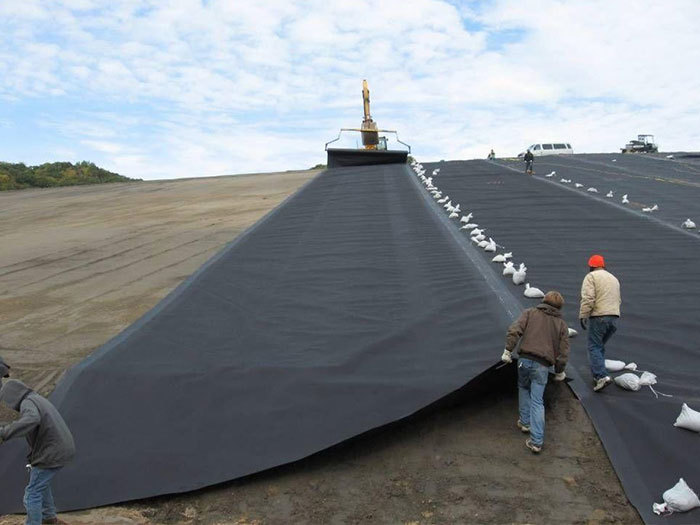
What is HDPE geomembrane?
Release time:
2025-03-03
geomembrane, as an important engineering material, has broad application prospects in the field of civil engineering.
Geomembrane is an important engineering material. The following is a detailed introduction to it:
1. Definition and raw materials
Geomembrane, whose English name is Geomembrane, is a waterproof barrier material made of high-density polyethylene resin through high-temperature melting, extrusion and calendering. It has a high anti-seepage coefficient and is usually used for tasks such as anti-seepage, isolation and drainage in civil engineering.
2. Classification
Geomembrane is mainly divided into the following categories:
Ordinary geomembrane (single membrane): only a single-layer membrane material, made of polymers, elastic materials and low-molecular materials through rolling or extrusion processes. It is a homogeneous film without any fabric reinforcement, with a typical thickness of 0.254mm (extrusion process) and 0.252mm (rolling process).
Composite geomembrane: It is made by heating and pressing a polymer film and geotextile or bonding them with an adhesive. It can be a layer of membrane and a layer of fabric pressed together (commonly known as one cloth and one membrane), or two layers of fabric pressed together with a layer of membrane (two cloths and one membrane), and it can also be made into three cloths and two membranes according to engineering needs. The advantage of this membrane is that geotextiles can protect the geomembrane from being punctured by gravel, damaged by humans and crushed by machinery. In addition, geotextiles have a drainage effect and can also increase the friction coefficient with the contact surface.
Reinforced geomembrane: In order to improve the tensile, bursting and tearing strength of the geomembrane, reinforcement is added inside the polymer. The reinforcement material is generally nylon silk cloth, nylon canvas, polypropylene needle-punched fabric, etc. According to the needs of the project, the number of reinforcement layers can be selected as one, two or three layers.
3. Performance characteristics
The performance of geomembranes generally includes physical, mechanical, hydraulic and durability properties. The specific characteristics are as follows:
Superior anti-seepage performance: It has a high anti-seepage coefficient and can effectively prevent water penetration.
High strength: It has good tensile and tearing strength and can adapt to various complex terrains and construction conditions.
Aging resistance: It uses high-density polyethylene resin as raw material, has good aging resistance and long service life.
Strong adaptability: It can adapt to different climatic conditions and soil environments and is widely used in various civil engineering fields.
4. Application fields
Geomembrane has a wide range of applications in the field of civil engineering, including but not limited to the following aspects:
Environmental protection field: used for landfills, sewage treatment plants, power plant regulating pools and industrial solid waste treatment, effectively preventing the spread of pollution.
Gardening: widely used in artificial lakes, river reservoirs, golf course pond bottoms and slope protection, as well as green lawn waterproofing and moisture-proof projects.
Petrochemical industry: used for chemical plants, petroleum plants, oil storage tanks, chemical reaction tanks and sedimentation tanks for anti-seepage, to ensure the safety and environmental protection of chemical production.
Mining field: used for anti-seepage of the bottom lining of washing pools, heaps, ash dissolution pools and sedimentation tanks, effectively protecting the environment.
Transportation facilities: used for highway foundation reinforcement and culvert anti-seepage, improving the stability and durability of road infrastructure.
Aquaculture: used for intensive factory breeding ponds, fish ponds, lined sea cucumber circles and lakes, etc., to provide a good breeding environment.
Agricultural field: used for anti-seepage of reservoir pools, water storage tanks, irrigation systems and canals to improve agricultural irrigation efficiency.
Water conservancy projects: used for anti-seepage, plugging and reinforcement of river, lake and reservoir dams and anti-seepage of canals to ensure the stable operation of water conservancy projects.
Municipal engineering: used for anti-seepage of subway buildings, underground projects, planted roofs and roof gardens, as well as the construction of sewage pipes to improve the quality of urban infrastructure.
5. Construction technical requirements
The construction technology requirements of geomembranes are strict, mainly including the following aspects:
 |
In summary, geomembrane, as an important engineering material, has broad application prospects in the field of civil engineering. Understanding its definition, classification, performance characteristics, application fields, and construction technical requirements is of great significance for the correct selection and use of geomembranes.
Construction preparation: ensure that the construction area is clean and tidy, the ground is flat, and there is no debris and debris.
Laying the film: Lay in one direction to ensure that the film is flat and moderately tight, and reserve a certain length of edge for subsequent connection.
Connection treatment: Use hot melt or adhesive connection methods to ensure that the connection is flat and wrinkle-free to prevent leakage.
Compacting and trimming: After connection and laying, compact the geomembrane appropriately to enhance its fit with the ground, and trim the edges to ensure a tight fit.
Filling soil: When filling the soil inside the geomembrane, be careful to avoid excessive compaction to maintain the air permeability and permeability of the soil.
Detection and maintenance: After construction is completed, conduct leakage detection to ensure that the geomembrane has no leakage. Regularly inspect and maintain the geomembrane, and repair or replace it in time if damaged.
PROJECT CASES
Apr 25,2024
Apr 25,2024
Apr 25,2024
Apr 25,2024
Apr 25,2024
Apr 25,2024
Apr 25,2024
Apr 25,2024



